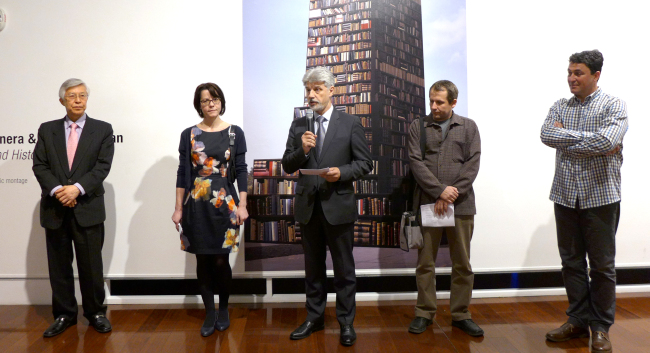A group of Romanian artists is displaying work that delves into life during and after communism, revealing a complex world of creativity and resistance.
The “Pocket Revolutions: Romanian Contemporary Art” exhibition at the Korea Foundation Gallery from April 3-18 in Seoul celebrates the silver jubilee of relations this year and pays tribute to the communist legacies of Romania.
Photographs, films, sculptures, books and paintings by eight artists reveal a complex reality of the country’s turbulent and disjointed epochs ― communist rule from the 1947 and 1989 revolution; the dawn of democracy and capitalism; and the 21st-century postindustrial world.
The exhibition includes the documentary “Battling Inertia” (2010) by Matei Bejenaru, photography professor at George Enescu Arts University in Iasi, Romania, which portrays a poetry club in an industrial factory in Iasi.
“‘Battling Inertia’ is the title of a famous 20th-century national poem, which became the club’s name and my work,” Bejenaru told The Korea Herald. “The idea was to hear people’s voices through poems about love, philosophy, passing time and the human relationship with nature.”
The “Pocket Revolutions: Romanian Contemporary Art” exhibition at the Korea Foundation Gallery from April 3-18 in Seoul celebrates the silver jubilee of relations this year and pays tribute to the communist legacies of Romania.
Photographs, films, sculptures, books and paintings by eight artists reveal a complex reality of the country’s turbulent and disjointed epochs ― communist rule from the 1947 and 1989 revolution; the dawn of democracy and capitalism; and the 21st-century postindustrial world.
The exhibition includes the documentary “Battling Inertia” (2010) by Matei Bejenaru, photography professor at George Enescu Arts University in Iasi, Romania, which portrays a poetry club in an industrial factory in Iasi.
“‘Battling Inertia’ is the title of a famous 20th-century national poem, which became the club’s name and my work,” Bejenaru told The Korea Herald. “The idea was to hear people’s voices through poems about love, philosophy, passing time and the human relationship with nature.”

Featuring a unique combination of machines and poems, the 84-year-old former employee Alexandru Tacu narrates how workers “battled the inertia” of their lives through literature.
“The workers, instead of going home after work to drink beers, read and listened to poetry,” said Bejenaru. “Can you imagine this in a capitalist society, with all its technology and fashion?”
When Bejenaru reentered a factory library where club members gathered nearly 20 years after it was locked up in 1991, “All scientific books and manuals were frozen in time,” he said. As factories went bankrupt in the early 1990s and technology evolved, the knowledge became obsolete.
Communist states around the world channeled national resources to develop heavy industries to “catch up” with the advanced West. However, Romania lost an edge in a technology-driven world economy, Bejenaru said.
“This idea of making progress was doomed from the start because our talent was pressed into an ideological cage of communism,” he added. “As much as the regime tried to enforce its vision, there was resistance.”
Adapting to life under capitalism has been equally arduous, he stressed. Unemployment and emigration have increased in Romania since the 2008 global financial crisis, despite joining the European Union in 2007.
Iasi is now a university town of 80,000 students. There are voluntary poetry associations, although not as many or as vigorous as its heyday.
“Who cares about poetry these days?” Bejenaru asked. “People have to be pragmatic to make money. Poetry is contemplating about life, thinking differently from what’s normal.”
Florin Dan Prodan’s “Six Portraits and a Pullover” (2015) is an anthology of poems dedicated to casualties of Romanian gulags. The Ceausescu regime imprisoned and killed over 1 million liberal politicians, intellectuals, students, artists, priests and peasants during its 24-year reign of terror.
“My work is a homage to core members of the Romanian Kingdom (1881-1947), which was a European and democratic nation before communism,” Prodan said. “Many Romanians didn’t know political prisons existed, and it is a sensitive issue, even today. We have a responsibility to remember their sacrifices.”
“Auditions for a Revolution” (2006) by Irina Botea includes television footage during the revolution which is played alongside recordings of Botea’s students from the University of Chicago, where she has taught video art, role-playing these moments.
Other works by Radu Cioca, Stefan Constantinescu, Dana Popa, Serban Savu, Anca Benera and Arnold Estefan are also on display at the exhibition.
Event curator Simona Nastac said some Romanians have nostalgia about what they lost: exuberance and innocence for youngsters, power and privilege for elites and a sense of security for people.
“But we clearly understand that what we gained in 1989 is far more important than what we lost. Communism was a failed project,” she said.
Romanians hated leader Nicolae Ceausescu, Nastac stressed, adding that what people see from outside is different from what occurs inside.
Ceausescu took power in 1965 with popular support, but over the years, the economy crumbled and people became impoverished. His cult personality and secret police created fear, preventing honest discussions among family members and pitting everyone against each other, according to Nastac.
“People knew it was all lies and propaganda,” she said. “I suspect in North Korea, too, fearing secret police, it would be very difficult to start a coherent movement of resistance.”
Art scenes in Romania and Eastern Europe are now dynamic and vibrant, due to support by American philanthropist George Soros from 1992, which was followed by the Erste Bank-Tranzit of Austria from 2002, noted Nastac.
Nastac is a curator of the “Kingston Welcomes Korea Festival 2015,” to be held in London from July 30 to Aug. 8, which will feature visual arts, music and drama.
By Joel Lee (joel@heraldcorp.com)
-
Articles by Korea Herald



![[Herald Interview] 'Amid aging population, Korea to invite more young professionals from overseas'](http://res.heraldm.com/phpwas/restmb_idxmake.php?idx=644&simg=/content/image/2024/04/24/20240424050844_0.jpg&u=20240424200058)















